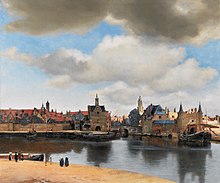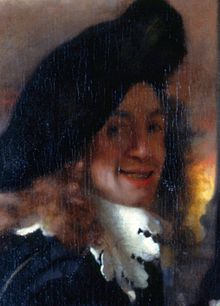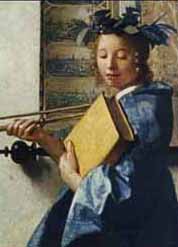The art of painting
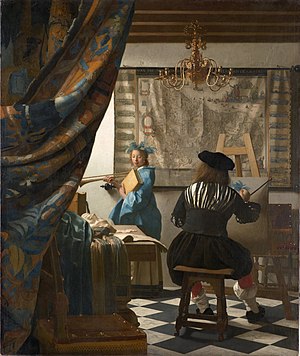
|
| The art of painting |
|---|
| Jan Vermeer , around 1666/1668 |
| Oil on canvas |
| 120 × 100 cm |
| Art History Museum |
The art of painting is a painting by the Delft painter Jan Vermeer (1632–1675), created around 1664/1668 or 1673, which is one of the artist's main works due to its light and shadow painting of the highest quality. The motif is seen as an allegory of art. A detailed interior scene is shown, in the center the painter himself sits in front of an easel and turns his back to the viewer. The model stands in the vanishing point of the picture and is masterfully accentuated by incident light. Celebration, silence and seclusion characterize the painting. In the course of its provenance history, the work has been given various titles, such as De Schilderconst , Allegory of Painting or The Artist in His Studio . Measuring 120 centimeters high and 100 centimeters wide, it is also one of Vermeer's larger pictures in its format. The painting has been exhibited in the Kunsthistorisches Museum in Vienna since 1946 . The ownership structure was controversial, as Adolf Hitler had bought it from the Austrian Counts Czernin in 1940 after a guide reservation , and was decided on March 18, 2011 by the Art Restitution Advisory Board in favor of the museum.
Image description
The painting shows the painter sitting on a stool in the center of a room, his back to the viewer. In front of him is an easel with a canvas primed gray that is still almost unpainted. In the vanishing point of the picture and illuminated by covered daylight, the model stands, a young woman in a wide-cut blue robe, wreathed with laurel, a book in her left hand and a trumpet in her right hand. The artist has only just begun his work, only the blue-green laurel wreath of the girl has been sketched, the posture of the man like his hand resting in front of the canvas, leaning on a cane , suggests that he is looking at his model with concentration. “Vermeer has captured the moment when the painter's head returns to the canvas from the direction of the living model in order to combine the external image perceived with the sense of sight with that in his imagination.” The painter's clothing, especially the beret , is striking . the Schlitzwams and the army Timpani make a man of education and status is.
A table still life is arranged between the painter, model and curtain ; an oversized mask and a sketchbook are highlighted from the incident light . In the upper area of the picture, a brass chandelier hangs from a wood-paneled ceiling, in which the light reflects and whose suspension consists of a double-headed eagle .
Behind the model, aligned to the right, hangs a map on the back wall , which is slightly creased and has clear cracks. It is inscribed on the upper border with the designation "Nova XVII Provinciarum Germaniae inferioris descriptio / et accurata earundem ... de novo emendata ... rectissime edita per nicolaum piscatorem". The illustration is based on a map of the Netherlands made by Nicolaes Visscher in 1636 with the seventeen provinces before the armistice with Spain in 1609. In the ornamental frame, ten Dutch cities are depicted on the left and right edges. These so-called cartridges are the cities of Brussels, Luxembourg, Ghent, Bergen ( Hainaut ), Amsterdam, Namen (Namur), Leeuwarden, Utrecht, Zutphen and The Hague on the left, and Limburg, Nijmegen, Arras, on the right. Dordrecht, Middelburg, Antwerp, Mechelen, Deventer, Groningen and again Brussels. The signature "I Ver-Meer" is on the lower edge strip, it is his largest signature ever.
The floor is represented by black and white marble tiles and shows Vermeer's preference for perspective and, at the same time, its mastery. The vanishing point is in front of the model, just below the wooden ball of the map rod. An X-ray of the picture showed that there was a small hole hidden under the paint. Vermeer put a needle in this place to draw guidelines with thread and chalk.
The front, left part of the picture is dominated by a lavishly woven curtain that falls in a soft throw, and a chair is shaded into it. This repoussoir darkens about a third of the picture, while the other two thirds of the picture appear to be flooded with light and contain the main events. With the applied golden ratio , the self-contained artistic unit is formed. As in a play, the heavy curtain is pushed aside and “the viewer is invited to take a seat on the straightened chair to take part in the painterly revelation with his own eyes” .
Origin and dating
During Vermeer's lifetime, the painting did not leave his studio , presumably there was no client, but was a self-fulfillment of the painter in the depiction of his art in the picture and served as a showpiece for potential buyers. After Vermeer's death in 1675, the special personal reference was also emphasized by his wife Catharina Bolnes, who had to forego her inheritance to settle debts. On February 24, 1676, she declared that she had given the work to her mother, Maria Thins, as a pledge to secure a loan of 1,000 guilders. She tried to prevent the painting from being auctioned off in an auction planned for March 15, 1677 under the direction of the estate administrator Antoni van Leeuwenhoek (1632–1723). The provenance of the painting, however, shows that she did not succeed.
The Californian art historian Svetlana Alpers argued in 1985 that the painting was originally ordered for the great hall of the Guild of St. Luke in Delft, of which Vermeer was temporarily chairman. She substantiated her view by stating that the branches that were united in the Guild of Luke are represented in the picture. The guild book of the Delft master painters, engravers, glaziers, sculptors and potters in the 17th century contains the following list:
"Volgens Ordonnantie Behoorden tot dat gild: All degeenen, the hair generen met de schilderkunst, hetzij met pencelen of andersints, in olye of waterverwen, as oock glaseschryvers, glasemakers, glasverkoopers, plattielbackers, tapissiers, borduurwerckers, plaetsnyders, werkende inyders end steen, often other substantia, scheemakers, konstdruckers, bouckverkoopers, hoedanig die souden like zijn.
The German art historian Hermann Ulrich Asemissen countered this by stating that the attributes depicted on the painting could have something to do with the professions that were associated with painting in the guild, but the three glazing professions and the potters of Delftware were important at the time Members of this guild, not included. The Dutch art historian Eric Jan Sluyter also contradicts Alpers and says that the Gild brothers would not have rejected such a great work, especially since Vermeer was one of their chairmen.
The chronological classification of Vermeer paintings is a fundamental problem for art historiography, because the painter himself only dated three of his paintings: The matchmaker (1656), The astronomer (1668) and The geographer (1668/1669). The dates of all the other pictures can only be assumed, as the few information available do not provide sufficient clues for a chronological classification. The art of painting has long been dated to around 1665/1666, the art historian Walter Liedtke limits the creation of the painting to the years 1666–1668, while among others the author Arthur K. Wheelock suspects that it was only created in 1673, i.e. after the Rampjaar ( Disaster year) of 1672.
Interpretations
The different opinions about the origin and dating are continued in the various titles and interpretations of the painting. When settling the estate, Catharina Bolnes named the picture De Schilderconst , literally translated into German Die Malerkunst . A note by the estate administrator in the notary's files described “een stuck schilderie… waerin worth uytgeheelt de Schilderkonst” (a piece of painting in which the art of painting is represented). The fact that apart from the remark in the notarial contract there are no written sources for the picture, that the history of origin, possible client or destination as well as the dating of this unusually large and complex picture are not known, led to various interpretations and controversial arguments among art historians.
The painter
Because of the motif, the painting was long regarded as a self-portrait , so the French art historian Théophile Thoré (1807–1869) Vermeer dans son Atelier (Vermeer in his workshop) and the writer André Malraux (1901–1976) simply called it atelier . In particular, the similarity of the figure in the Vermeer painting, Also wearing a beret and slit doublet , with the matchmaker suggests a self-portrayal. Thieme / Becker also lists the picture with the title The Painter in the Atelier , but the entry expressly points out that it is an allegory and is based on a fantasy self-portrayal, "combining appearance and reality in an unsurpassable way" .
In the iconography , this assumption has prevailed, the presentation is as exaggeration of the genre picture Painter in the studio assumed to be a symbol. It was thus placed in relation to the Vermeer painting The Allegory of Faith , created between 1671 and 1674 , which conveys the personification of the abstract concept more clearly than the sign art.
The model
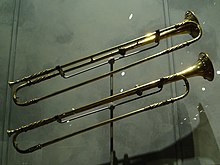
The depicted young woman is the starting point for a variety of interpretations. The Austrian art historian Hans Sedlmayr interpreted it as Fama in 1951, based on the attribute of the trumpet , the Roman embodiment of the uncontrollable rumor. The art historian Kurt Badt (1890–1973) contradicted Sedlmayr and came to the opinion that the model should personify Klio , the muse of history, recognizable by its own attributes of laurel wreath, trumpet and book. It inspires the painter and proclaims the glory of Dutch painting.
This interpretation is based on the fact that Vermeer was referring to the standard work for allegorical depictions Iconologia by Cesare Ripa from 1593, Dutch since 1644, which was widely recognized and widely used among painters in the 17th century . In his work, Ripa described pictorial translations of the nine muses with the seven arts , the four continents known at the time , as well as science and faith . From this it can be deduced that the portrayal of a muse in connection with an artist means his inspiration, the divine spark that emanates from her jumps over to the painter. Sluyter deepens this aspect and shows that this painting is mainly about fame, glory and honor, the laurel wreath, which is depicted twice, indicates this. The artists become immortal when their names are written down by others in the big book.
Other perspectives explain that the young woman could not represent Clio , but poetry : the trumpet and the evergreen laurel wreath are not limited to the representation of history, and in particular the blue dress as a reference to the heavenly art go back to the poetic allegory, as presented by Cesare Ripa.
In this context, the Dutch painter Gerard de Lairesse (1640–1711) wrote in his Groot Schilderboek :
"History and poetry ... show that they are the chief aids of art in order to provide her with rich thoughts and skillful materials for exercise and to decorate them gracefully."
The art historian Lida von Mengden, contrary to the interpretations of Sedlmayr and Badt, states that according to Horace's dictum “ ut pictura poesis ” (a poem is like a painting), the artist in reverse in the sense of “is a painting like a poem "should know, the adoption of literary models was common in Vermeer's time, the poetry was also related to the art of painting and as a further indication that the blue clothing was inappropriate for a representation of Clio, the muse of fame.
The map
Interpretations that criticize the classification of the art of painting in the tradition of the Paragons include the map by Nicolaes Visscher in their interpretations. Since this is a representation of the Netherlands before the armistice with Spain in 1609, which was historically out of date at the time the painting was created, it is in the context of Clio as the muse of history. The art historian Norbert Schneider puts the work in a historical-political context and interprets it as a tribute to Wilhelm III. of Orange . He also sees the Habsburg double-headed eagle incorporated in the chandelier as an allusion to the Holy Roman Empire . Schneider in the Bund Willems III provides the reference. with the Habsburg Emperor Leopold I at the beginning of the Franco-Dutch War , he therefore assumes that the painting is dated to 1673. Charles de Tolnay had already made a political interpretation in 1953, but was rejected by other art historians.
Provenance
The painting was in his possession until Jan Vermeer's death in 1675; his wife Catharina Bolnes was the direct heir. On February 24, 1676, she declared that she had given the work to her mother, Maria Thins, as a pledge to secure a loan of 1,000 guilders . Nevertheless, it was auctioned off on March 15, 1677 in Delft. The new owner was the Delft art collector Jacob Abramsz Dissius, who owned a total of 21 paintings by Vermeer.
On March 16, 1696, after Dissius' death in 1695, the entire collection was put up for auction at the Coelenbier auction house in Amsterdam. The Schilderconst was now for sale as a “portrait of Vermeer in a room with lots of accessories, of rare beauty, painted by himself” with an entry-level bid of 45 guilders. The buyer remains unknown, the further provenance of the painting is only known from the end of the 18th century. At the time it was owned by the Dutch diplomat Baron Gottfried van Swieten (1733–1803), son of Gerard van Swieten who was born in Leiden in 1700 and moved to Vienna with his families from the Netherlands in 1745 .
Ten years after Gottfried von Swieten's death, Rudolf Count Czernin acquired the picture from a Viennese saddler for 50 guilders in 1813. It was no longer known that it was a painting by Jan Vermeer, but was attributed to the painter Pieter de Hoogh (1629–1684). It was not until 1860 that the director of the Königliche Gemäldegalerie Berlin, Gustav Friedrich Waagen (1794–1868), recognized Vermeer's masterpiece. The painting remained in the Czernin von und zu Chudenitz family for several generations .
Franz Jaromir Eugen Graf von Czernin (1857–1932) adopted Eugen Graf Czernin (1892–1955) in 1927. Eugen was the biological son of Rudolf Graf Czernin von und zu Chudenitz and Morzin (1855-1927) and his first wife Emma Countess von Orsini-Rosenberg (1858-1905). When Franz Jaromir Eugen Graf von Czernin died in 1932, Eugen and his nephew Jaromir Czernin (1908–1966) jointly inherited the picture.
Jaromir wanted to sell it to the American collector and former Treasury Secretary Andrew W. Mellon (1855–1937) in 1935 , although he knew that this was not possible due to the Austrian Export Prohibition Act of 1923. He relied entirely on his brother-in-law, the then Austrian Chancellor Kurt Schuschnigg . This should give him the necessary export permit. Schuschnigg, however, did not do Jaromir this favor, as the picture enjoyed extraordinary veneration in Vienna, and in 1938 the relevant laws in Austria were even tightened, so that a sale abroad was now completely hopeless.
After the occupation of Austria and the annexation to the German Empire, however, new perspectives opened up and Czernin now led sales negotiations with the Hamburg industrialist Philipp Reemtsma (1893–1959), another interested party was Hermann Göring . The sales negotiations were ended by an order from Hitler stating that no disposition could be made without his personal approval. As a further measure, in 1940 he commissioned the head of the Reich Chancellery, Hans Heinrich Lammers , to purchase the painting. In the course of this mediation, the head of the party chancellery Martin Bormann , the former Reich Governor of Vienna Arthur Seyss-Inquart and the subsequent Reich Governor Baldur von Schirach also intervened. In October 1940, the sales contract between Hitler, represented by the authorized art dealer Hans Posse , and the Czerninschen Gemäldegalerie came about, the sales price was 1.65 million Reichsmarks and a waived tax of around 500,000 Reichsmarks. The payment was made in January from the Linz special fund , and Hitler had the painting brought to the studio of his Berghof . It is not legally clear whether the painting was bought privately by Hitler or for the planned Führer Museum in Linz. However, the picture adorned an edition of “Kunst dem Volk” from April – May 1943, in which a “new acquisition for the gallery in Linz” is clearly indicated on the cover and in the text content.
Towards the end of the war, the painting was moved to the Bad Aussee depot for security . There it was seized by American soldiers in April 1945 and initially brought to the Central Collecting Point in Munich. In 1946 the restitution was made to the Austrian authorities. It has been on display in the Kunsthistorisches Museum in Vienna since 1952.
Return claims
While Eugen Graf Czernin and his heirs no longer made any claims for restitution after the end of the war, Jaromir Graf Czernin tried to have the painting returned as early as November 1945 because he allegedly had to sell the painting to Hitler. In a total of three legal proceedings, the last one in 1960, his claims were each rejected as unfounded. With the change in the legal situation through the Washington Declaration of 1998, the case was re-examined. In September 2009, the heirs of the Czernin family submitted another request for return. After examining the case by the Commission for Provenance Research of the Federal Ministry for Education, Art and Culture , the Art Restitution Advisory Board decided unanimously on March 18, 2011 not to recommend restitution. He stated that Czernin had completed the sale to Hitler without coercion. In addition, the sale was actively pursued by Czernin's lawyers, but Hitler did not actively pursue the acquisition of the painting. According to the Art Restitution Advisory Board, Czernin's assertion that he was subject to political repression could not be substantiated, especially since Czernin's application for admission to the NSDAP of April 1940 did not speak for a distanced attitude towards the NS regime. A causal connection between anti-Semitic hostility towards Alix Czernin and the sale of the picture by her husband to Hitler could not be recognized according to the Art Restitution Advisory Board.
Title used
In the course of its provenance history, the painting was carried under different titles. Mainly, these differ depending on the weighting of the interpretation between the designation of a genre painting painter and model or that of an allegory of the art of painting . The following table lists the frequently used titles and is not exhaustive.
| Title used | Year | annotation |
|---|---|---|
| De Schilderconst | 1675 | Catharina Bolnes, according to a note from the estate administrator (German: Die Malkunst / Painting); in today's Dutch it is written De Schilderkunst |
| Vermeer in his studio | around 1850 | Théophile Thoré; (German: Vermeer in his studio) |
| The painter in the studio | 1940 | Ulrich Thieme, Felix Becker |
| The artist workshop | 1945 | Linz collection under inventory number 1096a; Collecting Point Munich under inventory number 1284 |
| Allegory of Painting | 1948 | AB de Vries |
| L'Atelier de Vermeer | 1953 | Charles de Tolnay; (German: The studio of Vermeer) |
| Glory of the art of painting | 1960 | Hans Sedlmayr |
| Model and painter | 1961 | Kurt Badt |
| The art of painting | 1988 | Hermann Asemissen; This is the title under which the painting is exhibited at the Kunsthistorisches Museum Vienna |
See also
literature
- Hermann Ulrich Asemissen: Jan Vermeer. The art of painting. Aspects of a job description. Fischer, Frankfurt am Main 1988, ISBN 3-596-23951-6 .
- Kurt Badt : "Model and Painter" by Vermeer. Problems of interpretation. A pamphlet against Hans Sedlmayr. Dumont, Cologne 1961. (New edition: 1997, ISBN 3-7701-4013-3 ).
- Sabine Haag , Elke Oberthaler, Sabine Pénot: Vermeer - The art of painting. Residence, Vienna 2010, ISBN 978-3-7017-3187-9 .
- Susanne Hehenberger, Monika Löscher: The painting art sold. Jan Vermeer's paintings in the 20th century. Series of publications by the Commission for Provenance Research, Volume 4, Böhlau Verlag, Vienna 2013, ISBN 978-3-205-78816-4 .
- Norbert Schneider : Vermeer 1632–1675. All paintings. Concealment of the feelings. Taschen, Cologne 1996, ISBN 3-8228-6377-7 .
Web links
- The Art of Painting - Description of the pictures , accessed on December 23, 2009
- Art & Politics: The Art of Painting - Backgrounds , accessed on December 26, 2009
- Interview with Susanne Hehenberger and Monika Löscher (provenance researchers on behalf of the Commission for Provenance Research) on the tradition of the painting
proof
- ↑ a b c Vermeer, Johannes . In: Hans Vollmer (Hrsg.): General lexicon of fine artists from antiquity to the present . Founded by Ulrich Thieme and Felix Becker . tape 34 : Urliens – Vzal . EA Seemann, Leipzig 1940, p. 269 .
- ↑ a b Christiane Rambach: Vermeer and the sharpening of the senses. Weimar 2007, ISBN 978-3-89739-570-1 , p. 107.
- ↑ Kees Zandvliet: Vermeer en de cartography van zijn tijd. In: De wereld der leererdheid rond Vermeer , 1996, ISBN 90-400-9824-7 , p. 69
- ↑ James A. Welu: The Map in Vermeer's' Art of Painting. In: Imago Mundi 30, 1978, p. 19.
- ^ Philip Steadman: Vermeer's Camera. Uncovering the truth behind the masterpieces , Oxford University Press 2001, ISBN 0-19-215967-4 , p. 169. The black and white pattern is executed in eight other paintings by Vermeer: The Girl with the Wine Glass (1659/1660), The Music Lesson (1662–1665), The Concert (1665/1666), The Love Letter (1669/1670), Letter Writer and Maid (1670), Allegory of Faith (1671–1674), The Standing Virginalspielerein (1673–1675), The seated virginal player (1673–1675).
- ↑ Jens Schröter: The painting of painting. Picturesque depictions of the painting process from Vermeer to Pollock . In: Critical Reports. No. 1/99, pp. 17-28; Available online under Theory of the Media. Accessed December 25, 2009.
- ^ A b John Michael Montias : Vermeer and his Milieu. A Web of Social History. Princeton 1989, ISBN 0-691-00289-4 , pp. 338 f .; partly available online at google books accessed on December 26, 2009.
- ↑ Svetlana Alpers: Art as a Description. Dutch painting of the 17th century. Cologne 1985, ISBN 3-7701-4445-7 , pp. 165-167.
- ↑ 'Following one order belong to that guild: All those who deal with the art of painting, either with brushes or something else, in oil or water color, as well as glass painters, glassmakers, glass sellers, faience potters, picture makers, knitting workers , Engraver, sculptor or carver, active in wood or stone, or any substance, Scheidemacher, art printer, book seller, and such more. ' In: Guild Book of Delft Master Painters in the Seventeenth Century. Accessed December 23, 2009. This website also contains a picture of the Guild House on Voldersgracht.
- ^ Hermann Ulrich Asemissen, Gunter Schweikhart: Painting as a theme of painting. Berlin 1994, ISBN 3-05-002547-6 , p. 156.
- ↑ Eric Jan Sluyter: Vermeer, Fame, and Female Beauty, The Art of Painting. In: Ivan Gaskell, Michiel Jonker: Vermeer Studies. National Gallery of Art, 1998, p. 278.
- ↑ Irene Netta: The phenomenon “time” with Jan Vermeer van Delft. Hildesheim 1996, ISBN 3-487-10160-2 , p. 96.
- ^ Arthur K. Wheelock Jr .: Vermeer & The Art of Painting. Yale 1995, ISBN 0-300-06239-7 , p. 132.
- ↑ quoted from: Hermann Ulrich Asemissen, Jan Vermeer. The art of painting. Aspects of a job description. Frankfurt / Main 1988, ISBN 3-596-23951-6 , p. 6.
- ^ André Malraux: Artiste à jamais inconnu (1952) in: Œuvres complètes IV, Paris 1989-2010.
- ^ Hans Sedlmayr: Jan Vermeer. The glory of the art of painting. In: ders .: Epochs and Works. Vol. 2. 1951. Reprint, Vienna 1960, pp. 107–116; see also: Jan van Gelder: De schilderkunst van Jan Vermeer: een voordracht met commentaar van JA Emmens. Utrecht 1958, p. 10.
- ↑ Kurt Badt: "Model and Painter" by Vermeer. Problems of interpretation. A pamphlet against Hans Sedlmayr. Cologne 1961, new edition 1997, ISBN 3-7701-4013-3
- ^ The Art of Painting National Gallery of Art Washington: Johannes Vermeer. The Art of Painting , accessed December 23, 2009.
- ^ Hermann Ulrich Asemissen, Jan Vermeer. The art of painting. Aspects of a job description. 1988, p. 48.
- ↑ Eric Jan Sluyter: Vermeer, Fame, and Female Beauty, The Art of Painting. 1998, p. 269.
- ^ Edward A. Maser: Cesare Ripa. Baroque and Rococo. Pictural Imagery. The 1758–1760 Hertel edition of Ripa's "Iconologia" with 200 engraved illustrations. Toronto 1971, ISBN 0-486-26595-1 , p. 183; available online to a limited extent at The Hertel Edition , accessed December 25, 2009.
- ↑ in the following cited from: Gregor JM Weber, Jan Vos: The lob topos of the living image: Jan Vos and his "Zeege der Schilderkunst" from 1654 , Hildesheim 1991, ISBN 3-487-09604-8 , p. 61.
- ↑ Lida von Mengden: Vermeer's “De Schilderconst” in the interpretations of Kurt Badt and Hans Sedlmayr. Problems of interpretation. Frankfurt / Main 1984, ISBN 3-8204-8003-X , p. 48.
- ^ Norbert Schneider: Vermeer 1632–1675. All paintings. Concealment of the feelings. Cologne 1996, ISBN 3-8228-6377-7 , p. 81 ff.
- ^ Charles de Tolnay: L'Atelier de Vermeer , Gazette des Beaux-Arts X: I, 1953, pp. 265-272.
- ↑ See among others: Jan van Gelder: De schilderkunst van Jan Vermeer: een voordracht met commentaar van JA Emmens , 1958, p. 10.
- ↑ John Michael Montias: Vermeer and his Milieu. A Web of Social History. 1989, p. 265 ff.
- ↑ John Michael Montias: Vermeer and his Milieu. A Web of Social History. 1989, p. 364.
- ^ Robert Adrian, Reinhard Braun: Art & Politics. A network sculpture: Consequences of possession , accessed December 26, 2009.
- ^ Gustav Friedrich scales: Handbook of the German and Dutch schools of painting. Volume II, Stuttgart 1862, p. 110.
- ↑ The specific inheritance relationships over the Czerninsche Galerie were such that the adoptive son Eugen Czernin received the entire collection and a share of a fifth of Vermeer's painting art . Jaromir Czernin thus owned four fifths of the painting. See: Hitler's Vermeer May you, my Führer, give pleasure , Süddeutsche, December 15, 2009, accessed on September 4, 2018.
- ↑ a b The Painting's Afterlife at nga.gov, accessed on January 14, 2014
- ↑ a b Gunnar Schnabel, Monika Tatzkow: Nazi Looted Art. Manual. Art restitution worldwide. Berlin 2007, ISBN 978-3-00-019368-2 , p. 307 f.
- ↑ Jonathan Petropoulos: Art theft and collecting mania. Art and Politics in the Third Reich. Berlin 1999, ISBN 3-549-05594-3 , p. 234.
- ^ Heinrich Hoffmann: Art to the people . Special edition. Vienna 1943.
- ↑ alien.mur.at
- ^ The Painting's Afterlife at nga.gov, accessed Jan. 14, 2014
- ↑ Hitler's Vermeer May you, my Fuehrer, enjoy it , Süddeutsche, December 15, 2009, accessed on September 4, 2018.
- ↑ Heirs' Claim for Hitler's Vermeer Rejected by Austrian Panel , an article written by Catherine Hickley and published on March 18, 2011 at Bloomberg.com (English)
- ↑ wien.orf.at Vermeer painting will not be restituted. wien.orf.at, March 18, 2011.
